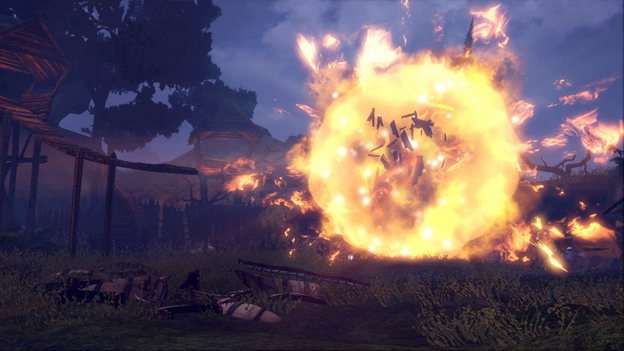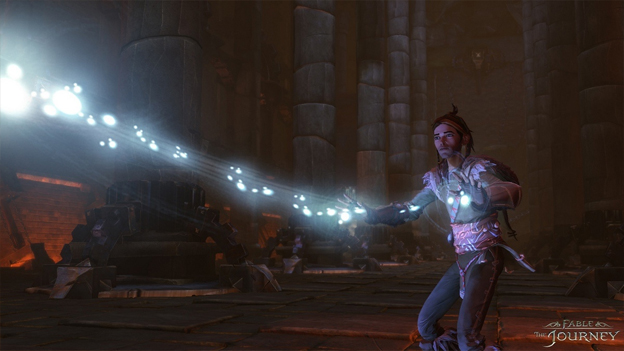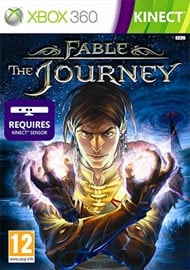Motion Magic
When motion controls were first introduced, just about every game developer out there promised amazing immersive hardcore experiences. You couldn’t see a Kinect commercial without some eighteen-year-old kid holding his hands up like he were carrying a gun to the sounds of gunfire in the background. Yet we are now nearing the end of this console generation, and motion controls still haven’t delivered on that promise. Instead of hardcore virtual reality experiences, we got waggle fests, minigame compilations, and stacks upon stacks of casual game shovelware. Heck, the most hardcore experiences we have for Kinect are Dance Central and Child of Eden, a rhythm game and a rhythm-based rail shooter respectively.
Fable: The Journey tries to change all that by bringing an actual core gaming experience to a motion-control platform, and it largely succeeds. However, even with the impressive amount of thought and planning put into the game, its control scheme still makes it fall a few steps short of “hardcore.” At the very least, we are getting closer.

Fable: The Journey, is essentially a magic-themed rail shooter. (Without an accurate way to simulate walking, on-rail games seem to be the best way to go with motion controlled experiences.) You take control of Gabriel, a stereotypical-youth-turned-unexpected-hero who has to reunite his tribe and ultimately save the world from something called The Corruption. In order to live up to his fate, Gabriel needs to embark on a journey (you see what I did there) along with his trusty steed Seren.
Along the way, you’ll meet some familiar faces, uncover some interesting backstory, and do all the things you’d expect to do in an epic RPG—except you’ll do it all on rails. It’s not the most convincing writing I’ve ever seen in an RPG, but it’s enough to get you involved. You never particularly care about the fate of the protagonist, but you do end up getting curious about the fates of the secondary characters he meets, and that’s more than enough to keep you playing.
Fable: The Journey is actually played while sitting down, unlike most motion-controlled games on the market. This allows you to play the game for long periods of time without tiring yourself out. It’s very refreshing to see a developer finally get this right. No one wants to stand for hours on end just to play a video game. You only really ever do two different things in Fable: The Journey: You’ll either be controlling your horse-drawn cart by pulling on the reigns, or you’ll be battling enemies by flinging around magic spells.
The controls for the horse segments are simple: Pull your hands forward or back in order to turn your horse and crack the reigns in order to make it go faster. Unfortunately, the game doesn’t particularly care if you do any of this. Unless there is danger nearby, you can pretty much just keep your hands on your lap and Seren will auto-steer herself to where you need to go. Okay, so it’s not exactly auto-steering—it’s more like running into the walls of the railed levels and simply letting them guide you—but, once again, if there’s no danger around you, you lose nothing by doing this.

When there is danger, you will be tasked with steering Seren safely out of the way of whatever is pursuing you. If she gets injured, you’ll then be tasked with healing her wounds, and you can also stop to brush her fur and feed her at points. This is all meant to get you attached to your horse as the game goes on, and, in a way, it works. However, the pacing of these sequences is a bit off. More often than not there won’t be any danger to your horse-drawn cart, and so large portions of the game are, essentially, spent staring at a horse’s ass as the game attempts to forward the plot. You particularly feel the plot drag at the beginning of the game, which will have you sitting at the reigns for hours before the action picks up. A couple horse sequences were fun, especially the chase scenes, but in general these were the low parts of the game.
The magical combat, on the other hand, is another story entirely. It’s easily one of the most interesting combat systems ever designed in a motion-controlled game. The controls here are fairly simple as well: Aim with your right hand and thrust forward to fire. However, you can’t get through each level just by firing off magic everywhere. Certain enemies will take cover or have different ways to shield themselves. That’s where the aftertouch ability comes in. After you fire off a spell, you can wave your arm to cause it to curve and change its direction in mid-air.

You also have a secondary ability to use a magic tether with your left hand. The magic tether is essentially a form of telekinesis, allowing you to lift, pull, tug, and throw enemies, as well as interact with the environment. Remember the main mechanic from Final Fantasy Crystal Chronicles: The Crystal Bearers? It’s a lot like that, except it’s pulled off way better here. You can pull skeletons apart piece by piece, levitate goblins into the air, and combo this all together with your standard attack spells.
All of this comes together to make an amazing gameplay experience. You really do feel like a wizard flinging bolts of energy at your enemies. Aftertouch, in particular, makes you feel badass as you curve your spells around cover to strike at your enemies. It gives you the same feeling you got when you played Child of Eden, a feeling that your motions and actions are actually directly translating to the spells you see on screen.
That being said, the game can get repetitive at times. Though you can upgrade your spells as the game goes on, your spells never change that much aside from having a bigger area to affect or doing more damage. You also only really have three spells to choose from, and they are all basically projectiles that, once again, operate very similarly to each other. You never actually get the feeling that you are getting more powerful like you would normally get in an RPG.

Luckily, the game manages to shake things up with its astounding boss fights and set pieces. You’ll fight enemies that tower above you, aiming for tiny weak points as they wreck the earth in your general vicinity. A lot of these bosses have a Legend of Zelda-esque puzzle feel to them. You’ll have to use your tether and magic spells in conjunction with each other in order to eventually make these bosses reveal their weak points and take them down. They are easily some of the most enjoyable battles in the game, and they happen often enough to keep the game feeling fresh without becoming stale themselves.
As fun as the game is, there are still some issues with the motion controls that need to be mentioned. Particularly, they don’t always work. The Kinect has a habit of making your spells fly off to the edges of the screen a good portion of the time. Sometimes it won’t pick up on your motions at all. A lot of these issues can be fixed by re-calibrating the Kinect, but this can only be done by quitting the campaign. It’s actually difficult to play the game for long periods of time without the calibration getting jacked up somehow. I frequently found myself quitting the game just because the Kinect was acting up and I didn’t want to go through the entire calibration process again.
Fable: The Journey doesn’t overstay its welcome. You can beat it in nine or ten hours, a far cry from the 30-hour epic stories of other Fable games. It’s a fun little side story that doesn’t hook you like other RPGs, but does keep you entertained for the most of its running time. Most importantly, Fable: The Journey is the closest thing we have to a hardcore motion-controlled game, and it sets some amazing groundwork for future motion titles. If motion controls survive long enough, Fable: The Journey proves that we may see them sneak into the hardcore scene yet.
RATING OUT OF 5 RATING DESCRIPTION 3.7 Graphics
The game gets down the signature Fable feel, somewhere between cartoon and storybook. 3.9 Control
The controls would be perfect if the Kinect didn’t keep decalibrating. 3.7 Music / Sound FX / Voice Acting
The voice acting and music fit the fantasy atmosphere the game is trying to create. 4.3 Play Value
It’s refreshing to see something so close to a hardcore motion-controlled game. 3.8 Overall Rating – Good
Not an average. See Rating legend below for a final score breakdown.
| Review Rating Legend | |||
|---|---|---|---|
| 0.1 – 1.9 = Avoid | 2.5 – 2.9 = Average | 3.5 – 3.9 = Good | 4.5 – 4.9 = Must Buy |
| 2.0 – 2.4 = Poor | 3.0 – 3.4 = Fair | 4.0 – 4.4 = Great | 5.0 = The Best |
Game Features:
